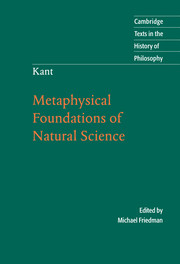Book contents
- Frontmatter
- Contents
- Acknowledgments
- Introduction
- Chronology
- Further reading
- Note on texts and translation
- Metaphysical Foundations of Natural Science
- Preface
- First Chapter Metaphysical Foundations of Phoronomy
- Second Chapter Metaphysical Foundations of Dynamics
- Third Chapter Metaphysical Foundations of Mechanics
- Fourth Chapter Metaphysical Foundations of Phenomenology
- Glossary
- Index
- Cambridge Texts in the History of Philosophy
Second Chapter - Metaphysical Foundations of Dynamics
Published online by Cambridge University Press: 05 June 2012
- Frontmatter
- Contents
- Acknowledgments
- Introduction
- Chronology
- Further reading
- Note on texts and translation
- Metaphysical Foundations of Natural Science
- Preface
- First Chapter Metaphysical Foundations of Phoronomy
- Second Chapter Metaphysical Foundations of Dynamics
- Third Chapter Metaphysical Foundations of Mechanics
- Fourth Chapter Metaphysical Foundations of Phenomenology
- Glossary
- Index
- Cambridge Texts in the History of Philosophy
Summary
Explication 1
Matter is the movable insofar as it fills a space. To fill a space is to resist every movable that strives through its motion to penetrate into a certain space. A space that is not filled is an empty space.
Remark
This is now the dynamical explication of the concept of matter. It presupposes the phoronomical [explication], but adds a property relating as cause to an effect, namely, the power to resist a motion within a certain space; there could be no mention of this in the preceding science, not even when dealing with motions of one and the same point in opposite directions. This filling of space keeps a certain space free from the penetration of any other movable, when its motion is directed towards any place in this space. Now the basis for the resistance of matter exerted in all directions, and what this resistance is, must still be investigated. But one already sees this much from the above explication: Matter is not here considered as it resists, when it is driven out of its place, and thus moved itself (this case will be considered later, as mechanical resistance), but rather when merely the space of its own extension is to be diminished. One uses the expression to occupy a space, that is, to be immediately present in all points of this space, in order to designate the extension of a thing in space.
- Type
- Chapter
- Information
- Kant: Metaphysical Foundations of Natural Science , pp. 33 - 74Publisher: Cambridge University PressPrint publication year: 2004



